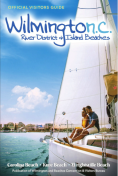Wilmington’s Cameron Art Museum (CAM) is excited to open the nation’s first United States Colored Troops (USCT) Park, which serves as a place for the community to come together and reflect on the contributions of USCT Regiment soldiers and look forward to the future. The USCT Park honors the 1,600 United States Colored Troops who once fought on the grounds of the museum, and features Boundless, a life-size bronze statue featuring 11 USCT Soldiers by sculptor Stephen Hayes.
A Quiet Place to Reflect
USCT Park serves as a new community space to promote discussions for the future and guide reflections on the past for the thousands of guests who visit the museum each year. The park, designed by Wilmington-based architectural firm LS3P, has educational signage and an informational kiosk to engage community members by thinking about the past, present and future of race as guests walk the very same ground as the Freedom Fighters.
Individual seating spaces are available throughout and near the park’s centerpiece, Stephen Hayes’s bronze-casted sculpture, Boundless, for personal and thoughtful contemplation. CAM also provides programming that explores the USCT story and aftermath of the Civil War in southeastern N.C., such as USCT living history events, conversation series, workshops and classes, live music, field trips, and free, weekly public tours on Fridays at 1 p.m. included with museum admission.
The Centerpiece
In development since 2019, “Boundless” sits poignantly as the centerpiece of the park to promote social change and reflection for reconciling past racial violence, and to move forward as an inclusive community.
North Carolina artist Stephen Hayes crafted the first figurative sculpture in the state to honor the USCT, featuring life-size depictions of Freedom Fighter soldiers marching to battle. He created it using the cast features of 11 African American men affiliated with the site and its story – USCT descendants, re-enactors, veterans and community leaders – to connect the USCT Park with those who have personal history with the battle. Hayes hopes his work brings both light and awareness to the community and highlights the area’s history.
Learning the History
The USCT Park grounds have a rich history. Well before it was home to the museum, the site was a Civil War battleground. Cover barriers remaining from battle still line the campus and serve as relics of its history. On Feb. 20, 1865, the Fifth Regiment of the USCT marched towards Forks Road on the very same land the park resides today. While the North fought to preserve the Union and the South fought for state’s rights, the USCT fought for their freedom.
While relatively small in scale, the Battle of Forks Road was a crucial turning point signaling the end of the Civil War. The battle was the final stop to secure Wilmington’s port and cut off the Confederacy’s last supply line to the Atlantic Ocean. Confederate General Lee was forced to surrender at Appomattox just two months later. More than 50% of the Union casualties on the campaign to reclaim Wilmington were men from the USCT Regiment, and without their sacrifice, Wilmington would likely have stayed in Confederate hands and the Civil War would have continued. Every anniversary the lives lost are commemorated with a live re-enactment of the battle and will now be supported by the addition of USCT Park.
The Battle of Forks Road documentary offers a 25-minute view into the Civil War encounter that led to the fall of Wilmington and focuses on the legendary victory and significant impact of the USCT. There are many stories, both told and untold, that celebrate and shine light on the African American Freedom Fighters’ battle to end the Civil War.
Park Opening
The USCT's impactful, virtually unknown story is timely and necessary, as our nation continues to examine issues of race and systemic racism. In celebration of the USCT, CAM invites guests to opening day Nov. 13, which will be filled with music, storytelling, food trucks, family activities and a ticketed-conversation with artist Stephen Hayes. This much anticipated event is intended to be a celebration of the opening of a new community space and a hub for reflection.

